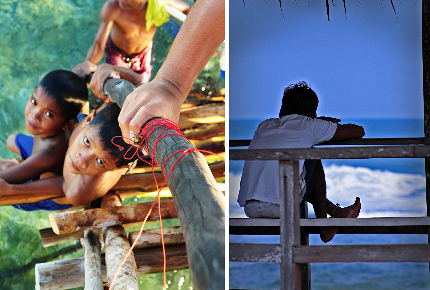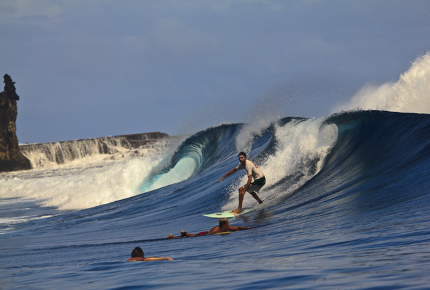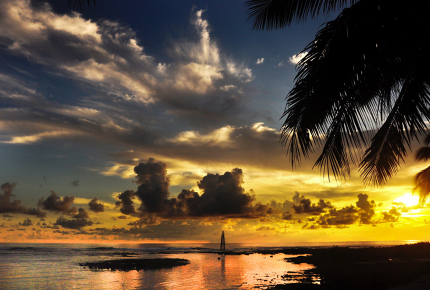Paradise Lost: Can the Philippines preserve Siargao Island?
A little-known surf paradise in the Philippines is about to get a big wave of tourism. Emilee Tombs asks if Siargao can preserve the very thing that attracted people to it in the first place.
The journey to Siargao should have taken an hour, but we’d already been in the air that long when an enormous cloud tore across the sky and chased us twice around the island.
When we finally touched down I realised that the runway we’d been circumnavigating was little more than a finger swipe through custard, a patch of scrubland disappearing into the jungle around it.
After hauling my bag from the prop plane, baffled at the lack of security checks, I climbed into a waiting jeepney, the ubiquitous and colourfully adapted American army jeeps used as public transport in the Philippines.
Bouncing along the dirt track was like stepping back in time. The only life in the dense palm jungle was around basic stilt huts clinging to the road edge. Bamboo frames held up corrugated iron roofs which acted as petrol stations. One litre of gas in a Coca Cola bottle would set you back 20p. Carabao grazed lazily in lush rice paddies; the smell of slow-cooked Lechon pig hung in the hot air.
Siargao (pronounced Shar-gow) is one of over 7,000 islands that make up the Philippine archipelago. Perched 448km (278 miles) off the coast of cacophonic Cebu, the teardrop-shaped isle is relatively unknown, except to the surfing community, for whom it is a mecca.
Compared to neighbouring Boracay (an island with a 5-star Shangri-La resort, full moon parties and a busy airport), Siargao is a sleepy sibling. There are no direct international flights and volatile weather makes current airline timetables chaotic.
But all this will change from 2015 as more than £400,000 is set to be spent on improving and extending Siargao’s Sayak Airport over the next three years.
 Siargao is a sleepy sibling to neighbouring Boracay
Siargao is a sleepy sibling to neighbouring BoracayCreative Commons / Matthew Herradura / Paolo-Marco-Mañalac
I was in Siargao to visit the legendary surf at Cloud 9, a break on the east coast made famous by the World Surf League in 2011. I also had a profound urge to set foot on one of the world’s last remaining undeveloped spots.
Whilst on the island I stayed at Buddha’s, a hippie collection of thatched bungalows and hammocks just metres from the beach. I’d rise each morning at 6am and make my way through palm fronds to the sand. I’d heave my board onto a waiting bangkang (a traditional wooden outrigger used to fish) that transported surfers beyond the reef.
By the time we’d reach the swell, the sun would be high and the heat intense. There were only ever a handful of other surfers to compete with, so I’d spend two blissful hours carving watery tracks before heading back for a breakfast of eggs, bacon and fresh calamansi juice. By 6pm I’d sit and watch another sunset, convinced I’d found a personal heaven, my own Cloud 9.
This feeling resonated with many of the expatriates I met on the island, including Gerry Degan, the owner of Sagana, a resort with direct access to the Cloud 9 surf spot.
Gerry and his Filipino wife moved here from Australia in 1995, when the tourism industry was non-existent. With the help of a local, Gerry bought a plot of land and opened the resort. The airport extension makes him anxious, but he’s pragmatic.
“It’s a catch-22,” he says. “We would all like to keep the charm of the undiscovered tropical paradise, but as word leaks out of course more people will come. As a business owner it makes things much easier, but as a surfer my concern is that the waves will become overcrowded and I came here to surf a quiet break.”
 Surfers tackle the legendary waves at Cloud 9
Surfers tackle the legendary waves at Cloud 9Creative Commons / Miguel Navaza
In an attempt to tackle overcrowding, Gerry has joined forces with other expatriates to form the Siargao Tourism Operators Association (STOA). They want to prevent the island from becoming another Boracay and hope to forge better communication between the government and Siargao.
Melot Abejo-Saminskiy is the association president, as well as a consultant for the Siargao Provincial Tourism Board. She is understandably positive about the airport plans, telling me that STOA were working with the Siargao Department of Tourism to ensure that more strategies, such as the one that declared Siargao a Protected Landscape and Seascape in 1996, are put in place to protect the island and the locals’ way of life.
A few full moons ago, Thailand’s Ko Phi-Phi island was as little-known as Siargao, but now it appears on the backpacker route and is overrun with drunk and irresponsible tourists who pay very little respect to their surroundings. When I last visited, the beaches of Ko Phi-Phi Leh, the island’s designated National Park, were strewn with cans and bottles.
Mr Cruje of the Surigao del Norte Provincial Tourism Office tells me that a multifaceted strategy is in place to keep Siargao sacred, which includes promoting the island as an ecotourism destination, having UNESCO recognise more of the region’s cultural and natural sights, and ensuring that tourism is spread evenly throughout the island’s nine municipalities (not just focusing on General Luna, where many surf resorts are found).
Similar preventative measures have worked for the Surin Islands in Thailand, a cluster of five atolls in the Andaman Sea that were officially declared National Parkland in the 1970s. The Department of National Parks (DNP) for the Surin Islands moved their headquarters onto the island in order to only allow mass tourism on their terms. Now tourists have to go through the DNP to book accommodation or travel to the islands.
 Is the sun about to set on the idyllic island?
Is the sun about to set on the idyllic island?Creative Commons / Matthew Herradura
I wonder if protection can be this much of a priority for the government of Siargao when both Melot and Mr Cruje tell me how important tourism is for the economic state of the island. In the period between 2013 and 2014, the number of international tourists flying to Siargao increased by 139%, while local employment is at an all time high.
For the most part, says Melot, this is down to tourism. But as with islands like Thailand’s Ko Phi-Phi, it’s the bars and the promise of a great party that will ultimately bring in more money. This has to be on the government’s mind.
“The increase in tourism for Siargao Island will help to alleviate the poverty of our people, and while I understand the concern of some people, there is no stopping development,” says Melot. “I believe that with cooperation from everyone, Siargao will remain, for the main, an undeveloped paradise, just one that is accessible to many.”
The fact is that Siargao is a destination growing in popularity, and at the moment the government either doesn’t have or doesn’t wish to disclose their plans to prevent it becoming another Ko Phi-Phi or Borocay. Therefore it is with a heavy heart that I assume that increased flights will mean Siargao will not stay sacred for much longer.
On the final day of my trip I’m out on the water again, watching as a group of young Filipinos carve up the competition, their professional cut backs drawing whoops from an admiring crowd. I sit back on my board and wonder how long the government, and those calling Siargao home, will be able to protect this idyllic slice of heaven.
NEED TO KNOW
Getting there
Flights from London Heathrow to Cebu via Hong Kong start from £575. Flight from Cebu to Siargao start at £23 each way.
Where to stay
Sagana Resort (tel: +61 4246 14323; www.cloud9surf.com) at Cloud 9 Siargao Island has doubles from £53 per night, including three meals per day. Buddha Resort (tel: +63 9282 079631; www.siargaosurf.com) at Catangnan, General Luna, Siargao Island also has doubles from £32 per night.
Do you have any Feedback about this page?
© 2025 Columbus Travel Media Ltd. All rights reserved. No part of this site may be reproduced without our written permission, click here for information on Columbus Content Solutions.









 You know where
You know where